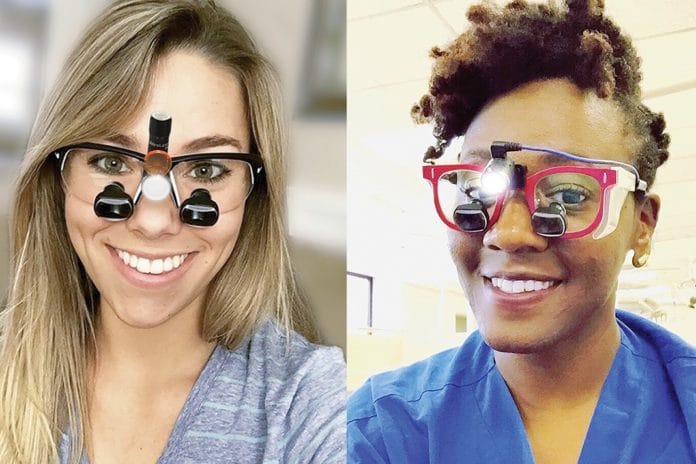Test Your Loupes & Magnification Knowledge
Disclosure: This quiz is sponsored content from Designs for Vision as part of our sponsored partner program.
Designs for Vision provides Hygienists with the Magnificaion essential to provide the best in patient care and the Ergonomic design to reduce neck and lower back pain.
- True 2.5X Magnification: Though some companies claim that magnification is not important, it is the most important feature of a magnification system. A system that magnifies the image only 2.0x reduces the users ability to visualize structures by a factor of 25%. Designs for Vision produces accurate precision magnification with maximum resolution.
- Thru-the-Lens (TTL) Optics: This lightweight system provides the Widest Field of View
- Ergonomically Correct – Made for YOUR eyes ONLY: Built to your Interpupillary Distance instead of one size fits all, these telescopes Incorporate your eyeglass prescription into both the carrier lens and the telescope.
- Unmatched Quality and Performance: Precision coated for the sharpest and clearest magnified image with excellent peripheral vision around the uniquely shaped telescope.
Now let's test your loupes & magnification knowledge!
The range within the appropriate working distance where the operator can maintain visual accuracy is called:
Depth of field is the range within the appropriate working distance where the operatory can maintain visual accuracy. Width of field is also referred to as “field of view,” this is the width and height of the area in the operator’s field of view. Declination angle is the degree the eyes of the operator are declined to view the area of treatment. Working distance is the distance between the plane of the eye of the operator and the area of treatment.
Abdulpur, M.S., Romibala, D.P., Archana, N., Superna, T. Magnification in Dental Practice: How Useful Is It? Journal of Health Research and Reviews in Developing Countries. 2015; 2(2): 39-44. Retrieved from http://www.jhrr.org/citation.asp?issn=2394-2010;year=2015;volume=2;issue=2;spage=39;epage=44;aulast=Mallikarjun;aid=JHealthResRev_2015_2_2_39_160903
Magnification aids can compensate for presbyopic visual constraints (a condition associated with the aging of the eye that results in progressively worsening ability to focus clearly on close objects). Presbyopia is common among people > 40 years of age.
Visual acuity can be improved by 250-961% with the use of magnification devices. Signs of presbyopia begin around the age of 40. Practitioners > 40 years of age have an average 72% lower visual performance compared to practitioners < 40 years of age.1,2
1. Eichenberger, M., Perrin, P., Neuhaus, K.W., Bringolf, U., Lussi, A. Visual Acuity of Dentists under Simulated Clinical Conditions. Clin Oral Investig. 2013; 17(3): 725‐729. doi:10.1007/s00784-012-0753-x. Retrieved from https://www.ncbi.nlm.nih.gov/pmc/articles/PMC3627031/
2. Eichenberger, M., Perrin, P., Sieber, K.R., Lussi, A. Near Visual Acuity of Dental Hygienists with and without Magnification. Int J Dent Hyg. 2018; 16(3): 357‐361. doi:10.1111/idh.12341. Retrieved from https://pubmed.ncbi.nlm.nih.gov/29603638/?from_term=loupes+and+dental+hygiene&from_pos=5
Which of the following are advantages to using loupes?
In addition to the above-mentioned advantages, dental practitioners that use loupes listed other advantages that included more accurate periodontal probing readings, restoration detection, quality of care, radiographic evaluations, and soft tissue evaluation.
Hayes, M.J., Taylor, J.A., Smith, D.R. Introducing Loupes to Clinical Practice: Dental Hygienists' Experiences and Opinions. Int J Dent Hyg. 2016; 14(3): 226‐230. doi:10.1111/idh.12128. Retrieved from https://pubmed.ncbi.nlm.nih.gov/25690424/
What is the ideal magnification for general dentistry purposes?
The lower magnification factor is beneficial because it is a compromise between visual acuity and ergonomics. The higher the magnification, the smaller the field of vision and range of focal distance compromising ergonomics, which could lead to musculoskeletal disorders.
Neuhaus, K., Perrin, P., Lussi, A. Substantial Difference between Declared and Real Magnification in Medical Loupes. Medical Instrumentation 2013; 1(2). Retrieved from http://www.hoajonline.com/journals/pdf/2052-6962-1-2.pdf
Are all 2.5x loupes really a true 2.5x magnification?
First, an understanding of diopter is helpful; diopter refers to the curvature of the lens. An increase in the curvature of the lens allows light rays to redirect and fill a greater portion of the retina; this causes objects to appear bigger. There are multiple formulas to convert diopter into magnification power. One common formula: Magnification = (Diopter / 4) +1; for example, a 3-diopter lens would make things 75% larger than it would appear with an unaided eye. Therefore, to state that a 5 diopter is equal to 2x magnification is simply misleading.
Unfortunately, when optical physics and physiology are ignored in telescope design, the poorly designed telescopes contribute to eye strain and poor posture leading to neck and lower back pain. The lower the magnification leads to improper posture because the user has to use their eyes' own refractive power to improve visualization. Also, the larger the depth of field causes the user to compromise their ideal working distance.
Designs for Vision’s loupes offer customized working distance to add comfort and reduce eyestrain and pain from poor ergonomics. Reflectance is another important factor in better vision with loupes. Most companies only use one layer of anti-reflectant. In contrast, Designs for Vision’s loupes has seven layers of anti-reflectant material coating the lenses, using 3 different materials, giving their loupes lower reflectance when compared to others. The lower the reflectance, the greater the depth of field.
Murphy, P. There is More to Optical Magnification than Meets the Eye. Retrieved from https://www.designsforvision.com/LitPDFs/MoreToMag.pdf
As the diameter of the magnifying lens increases, the magnification power decreases. As the lens size decreases, the magnification increases.
“Magnification power is a result of the amount of curvature in the magnifier lens. As the lens size increases, the amount of curvature in the lens decreases, resulting in lower magnification power of the lens. As the lens size decreases, the amount of curvature in the lens increases, resulting in higher magnification power of the lens. Therefore, higher magnification lenses are generally smaller in size than lower magnification lenses.”
BOLVL: Blaxall Optics Low Vision Limited. Magnifier Information. Retrieved from https://www.blaxalloptics.co.nz/magnification-facts.aspx












